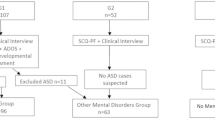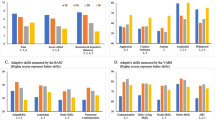Abstract
Objectives
The Social Communication Questionnaire (SCQ) is a common screening tool for autism spectrum disorder. Given its wide use, as well as recent changes to diagnostic criteria for autism, there is a need to evaluate whether the SCQ maps onto the social communication and interaction, and repetitive behaviour and restricted interests domains specified in the revised criteria in DSM-5.
Methods
Participants included 294 preschool aged autistic children. Confirmatory factor analysis was implemented to evaluate the factor structure of the SCQ.
Results
None of the models evaluated provided an adequate fit to the data. However, the best fitting model mapped onto the previous DSM-IV diagnostic criteria for autism.
Conclusions
The SCQ does not align with the new DSM-5 domains. More research is needed to evaluate the factor structure of the SCQ in different populations of autistic children in order to determine its current validity as a screening tool.



Similar content being viewed by others
References
Allen, C. W., Silove, N., Williams, K., & Hutchins, P. (2007). Validity of the social communication questionnaire in assessing risk of autism in preschool children with developmental problems. Journal of Autism and Developmental Disorders, 37(7), 1272–1278. https://doi.org/10.1007/s10803-006-0279-7.
American Psychiatric Association. (2000). Diagnostic and Statistical Manual of Mental Disorders DSM-IV-TR. 4th ed. Washington DC: American Psychiatric Publishing Inc.
Barnard-Brak, L., Brewer, A., Chesnut, S., Richman, D., & Schaeffer, A. M. (2016). The sensitivity and specificity of the social communication questionnaire for autism spectrum with respect to age. Autism Research, 9(8), 838–845. https://doi.org/10.1002/aur.1584.
Bentler, P. M. (1987). Comparative fit indices in structural models. Psychological Bulletin, 107, 238–246. https://doi.org/10.1037/0033-2909.88.3.588.
Berument, S. K., Rutter, M., Lord, C., Pickles, A., & Bailey, A. (1999). Autism screening questionnaire: Diagnostic validity. British Journal of Psychiatry, 175, 444–451. https://doi.org/10.1192/bjp.175.5.444.
Brown, T. A. (2006). Confirmatory factor analysis for applied research. New York, NY: The Guildford Press.
Browne, M. W., & Cudeck, R. (1993). Alternate ways of assessing model fit. In K. A. Bollen & J. S. Long (Eds), Testing structural equation models (pp. 136–162). Newbury Park, CA: Sage.
Centers for Disease Control and Prevention. (2014). Prevalence of autism spectrum disorder among children aged 8 years - autism and developmental disabilities monitoring network, 11 Sites, United States, 2010. MMWR Surveillance Summaries, 63, 1–21.
Charman, T., Baird, G., Simonoff, E., Chandler, S., Davison-Jenkins, A., & Sharma, A., et al. (2016). Testing two screening instruments for autism spectrum disorder in UK community child health services. Developmental Medicine and Child Neurology, 58, 369–375. https://doi.org/10.1111/dmcn.12874.
Chesnut, S. R., Wei, T., Barnard-Brak, L., & Richman, D. M. (2016). A meta-analysis of the social communication questionnaire: Screening for autism spectrum disorder. Autism, 21(8), 920–928. https://doi.org/10.1177/1362361316660065.
Corsello, C., Hus, V., Pickles, A., Risi, S., Cook, Jr, E. H., & Leventhal, B. L., et al. (2007). Between a ROC and a hard place: Decision making and making decisions about using the SCQ. Journal of Child Psychology and Psychiatry and Allied Disciplines, 48(9), 932–940. https://doi.org/10.1111/j.1469-7610.2007.01762.x.
Costello, A. B., & Osborne, J. W. (2005). Best practices in exploratory factor analysis: four recommendations for getting the most from your analysis. Practical Assessment, Research and Evaluation, 10(7), 1–9.
Eapen, V., Crncec, R., & Walter, A. (2013). Clinical outcomes of an early intervention program for preschool children with Autism Spectrum Disorder in a community group setting. BMC Pediatrics, 13, 3. https://doi.org/10.1186/1471-2431-13-3.
Glascoe, F. P. (2005). Screening for developmental and behavioral problems. Mental Retardation and Developmental Disabilities Research Reviews, 11(3), 173–179. https://doi.org/10.1002/mrdd.20068.
Hu, L., & Bentler, P. M. (1999). Cutoff criterion for fit indices in covariance structure analysis: Conventional criteria versus new alternatives. Structural Equation Modeling, 6, 1–55. https://doi.org/10.1080/10705519909540118.
Lee, L. C., David, A. B., Rusyniak, J., Landa, R., & Newschaffer, C. J. (2007). Performance of the Social Communication Questionnaire in children receiving preschool special education services. Research in Autism Spectrum Disorders, 1(2), 126–138. https://doi.org/10.1016/j.rasd.2006.08.004.
Lord, C., Rutter, M., DiLavore, P. C., Risi, S., Gotham, K., & Bishop, S. L. (2012). Autism diagnostic observation schedule (ADOS-2). 2nd ed. Los Angeles: Western Psychological Services.
Lord, C., Rutter, M., & Le Couteur, A. (1994). Autism diagnostic interview-revised: A revised version of a diagnostic interview for caregivers of individuals with possible pervasive developmental disorders. Journal of Autism and Developmental Disorders, 24, 659–685. https://doi.org/10.1007/BF02172145.
Magyar, C. I., Pandolfi, V., & Dill, C. A. (2012). An initial evaluation of the social communication questionnaire for the assessment of autism spectrum disorders in children with down syndrome. Journal of Developmental and Behavioral Pediatrics, 33(2), 134–145. https://doi.org/10.1097/DBP.0b013e318240d3d9.
Marvin, A. R., Marvin, D. J., Lipkin, P. H., & Law, J. K. (2017). Analysis of Social Communication Questionnaire (SCQ) Screening for Children Less Than Age 4. Current Developmental Disorders Reports, 4(4), 137–144. https://doi.org/10.1007/s40474-017-0122-1.
Muthén, L. K., & Muthén, B. O. (1998–2012). Mplus User’s Guide. 7th ed. Los Angeles, CA: Muthén & Muthén.
Myers, S. M., & Johnson, C. P. (2007). American academy of pediatrics council on children with disabilities. Management of children with autism spectrum disorders. Pediatrics, 120, 1162–1182.
Paynter, J., Riley, E., Beamish, W., Davies, M., & Milford, T. (2013). The double ABCX model of family adaptation in families of a child with an autism spectrum disorder attending an Australian early intervention service. Research in Autism Spectrum Disorders, 7, 1183–1195. https://doi.org/10.1016/j.rasd.2013.07.006.
Randall, M., Brignall, A., Sciberras, E., Ihsen, E., Efron, D., & Dissanayake, C., et al. (2016). Autism Spectrum Disorder: presentation and prevalence in a nationally representative Australian sample. Australian and New Zealand Journal of Psychiatry, 50, 243–253. https://doi.org/10.1177/0004867415595287.
Robins, D. L., Casagrande, K., Barton, M., Chen, C. M., Dumont-Mathieu, T., & Fein, D. (2014). Validation of the modified checklist for autism in toddlers, revised with follow-up (M-CHAT-R/F). Pediatrics, 33, 37–45.
Rosenberg, S. A., Moody, E. J., Lee, L.-C., DiGuiseppi, C., Windham, G. C., & Wiggins, L. D., et al. (2018). Influence of family demographic factors on social communication questionnaire scores. Autism Research, 11(5), 695–706. https://doi.org/10.1002/aur.1935.
Rutter, M. L., Bailey, A., & Lord, C. (2003). Social Communication Questionnaire (SCQ). Los Angeles, CA: Western Psychological Services.
Steiger, J. H., & Lind, J. M. (1980). Statistically based tests for the number of common factors. Iowa City, IA: Meeting of the Psychometric Society.
Tucker, L. R., & Lewis, C. (1973). A reliability coefficient for maximum likelihood factor analysis. Psychometrika, 15, 149–162. https://doi.org/10.1007/BF02291170.
Vivanti, G., Hudry, K., Trembath, D., Barbaro, J., Richdale, A., & Dissanayake, C. (2013). Towards the DSM V criteria for autism: clinical, cultural and research implications. Australian Psychologist, 48(4), 258–261.
Wei, T., Chesnut, S., Barnard-Brak, L., & Richman, D. (2014). Psychometric Analysis of the Social Communication Questionnaire Using an Item-Response Theory Framework: implications for the Use of the Lifetime and Current Forms. Journal of Psychopathology and Behavioral Assessment, 37, 1–12. https://doi.org/10.1007/s10862-014-9468-4.
Wiggins, L. D., Bakeman, R., Adamson, L. B., & Robins, D. L. (2007). The Utility of the Social Communication Questionnaire in Screening for Autism in Children Referred for Early Intervention. Focus on Autism and Other Developmental Disabilities, 22, 33–38. https://doi.org/10.1177/10883576070220010401.
Wing, L. (1981). Language, social and cognitive impairments in autism and severe mental retardation. Journal of Autism and Developmental Disorders, 10, 31–44.
Wing, L., & Gould, J. (1979). Severe impairments of social interaction and associated abnormalities in children: Epidemiology and classification. Journal of Autism and Developmental Disorders, 9(1), 11–29.
Acknowledgements
This project was funded by the Department of Social Services. The first author was supported by the Cooperative Research Centre for Living with Autism (Autism CRC), established and supported under the Commonwealth Government’s Cooperative Research Centres programme. The authors would like to thank all staff at the Autism Specific Early Learning and Care Centres involved in this study. We also sincerely thank the children and families who participated in this research.
Authors’ contributions
RG: designed the study, completed all data analyses, and drafted the manuscript. JP: collaborated with the design of the study, provided data, and assisted with the drafting of the manuscript. AJ: collaborated with the design of the study, provided data, and assisted with the drafting of the manuscript. GV: collaborated with the design of the study, provided data, and assisted with the drafting of the manuscript. CD: collaborated with the design of the study, and assisted with the drafting of the manuscript. VE: designed the study and assisted with the drafting of the manuscript.
Author information
Authors and Affiliations
Corresponding author
Ethics declarations
Conflict of interest
The authors declare that they have no conflict of interest.
Ethical approval
Ethical approval to conduct this study was obtained via the University of New South Wales Human Research Ethics Committee prior to the study commencing, and appropriate ethical guidelines were followed. Informed consent was obtained from all parents before their child was enrolled in the study.
Additional information
Publisher’s note: Springer Nature remains neutral with regard to jurisdictional claims in published maps and institutional affiliations.
Rights and permissions
About this article
Cite this article
Grove, R., Paynter, J., Joosten, A. et al. Factor Structure of the Social Communication Questionnaire in Preschool Aged Autistic Children. J Child Fam Stud 28, 3385–3391 (2019). https://doi.org/10.1007/s10826-019-01519-0
Published:
Issue Date:
DOI: https://doi.org/10.1007/s10826-019-01519-0




